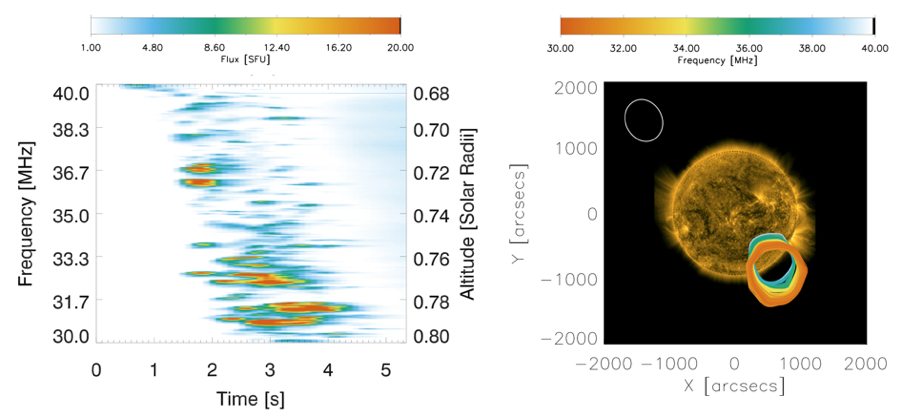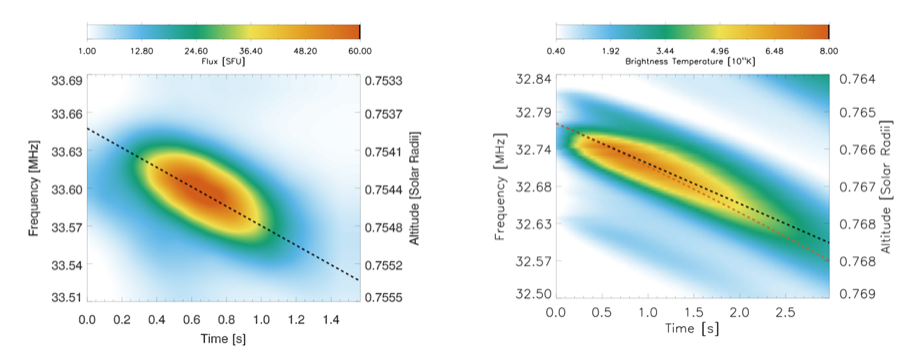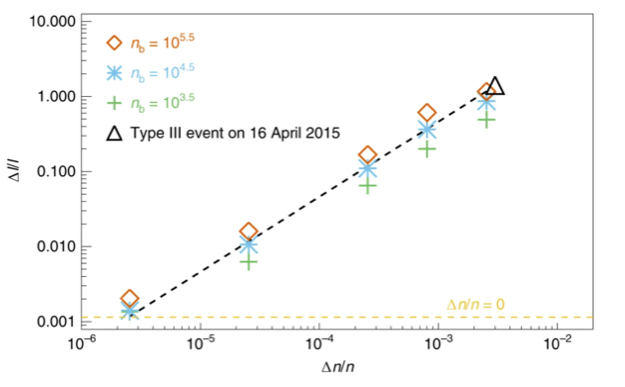The Sun routinely produces energetic electrons in its outer atmosphere that subsequently travel through interplanetary space. These electron beams generate Langmuir waves in the background plasma, producing type III radio bursts that are the brightest radio sources in the sky (Suzuki & Dulk, 1985). These solar radio bursts also provide a unique opportunity to understand particle acceleration and transport which is important for our prediction of extreme space weather events near the Earth. However, the formation and motion of type III fine frequency structures (see Figure 1) is a puzzle but is commonly believed to be related to plasma turbulence in the solar corona and solar wind.
A Recent work by Reid & Kontar, Nat Astro, 2021, combines a theoretical framework with kinetic simulations and high-resolution radio type III observations using the Low Frequency Array (LOFAR) and quantitatively demonstrates that the fine structures are caused by the moving intense clumps of Langmuir waves in a turbulent medium. These results show how type III fine structure can be used to remotely analyse the intensity and spectrum of compressive density fluctuations, and can infer ambient temperatures in astrophysical plasma, both significantly expanding the current diagnostic potential of solar radio emission.

Figure 1 – Dynamic spectra (left) and associated radio contours (right) of a solar type III radio burst observed by LOFAR on the 24 June 2015 at 12:18:20 UT. The LOFAR contours are at 75% of the peak flux of the type III bursts going from 40 MHz to 30 MHz in the colour sequence white-blue-green-yellow-red. The LOFAR beam contour at 75% for 30 MHz is shown in the top left corner in white. The background is the Sun in EUV at 171 Angstroms observed by AIA. Image from Reid & Kontar, Nature Astronomy, 2021.
The radio fine structures you can see in Figure 1 have a small drift in frequency, caused by the motion of Langmuir wave clumps moving through space at their group velocity. Measuring this frequency drift (Figure 2) allows us to deduce the Langmuir wave group velocity, and subsequently deduce the background thermal velocity. This new technique increases the scope of solar radio bursts to be used as a remote plasma temperature diagnostic. The observation infers a corresponding coronal plasma temperature around 1.1 MK. The radio fine structure also provides an additional way to estimate the electron beam bulk velocity, which is mostly controlled by the beam energy density.

Figure 2 – Magnification of one type III fine structure from the LOFAR data (left) and the simulations (right). The black dashed lines show a linear fit to the drift, estimating a constant velocity of 0.69 Mm/s for the observed type III burst and 0.6 Mm/s for the simulated type III burst. Image from Reid & Kontar, Nature Astronomy, 2021.
Type III radio emission fluctuates because the background electron density turbulence modulates the growth of Langmuir waves from the electron beam. The characteristic intensity of density turbulence parallel to the magnetic field, $\Delta n/n$ and the characteristic intensity of radio fine structure $\Delta I/I$ are analytically related via
\[\frac{\Delta n}{n} =\bigg(\frac{v_{\rm Th}}{v_b}\bigg)^2\frac{\Delta I}{I} \]
for the thermal velocity $v_{\rm Th}$ and the beam velocity $v_b$. The simulations also find the same relation (Figure 3). This new technique further increases the scope of radio fine structure to remotely determine the level of density turbulence, with the observations finding a level of 0.003.

Figure 3 – The relation between the radio fine structure $\Delta I/I$ and the level of density fluctuations $\Delta n/n$ found from different simulations. The black triangle shows the predicted level of turbulence from observations and the black dashed line shows the analytical relation between $\Delta I/I$ and $\Delta n/n$ from observations. Image from Reid & Kontar, Nature Astronomy, 2021.
In summary, the results create a framework for exploiting the diagnostic potential of radio burst fine structure to estimate plasma temperatures and density turbulence. This new potential is especially relevant given the enhanced resolution of new-age ground-based radio telescopes that are resolving much more fine structure originating from the solar corona. Moreover, the closer proximity of Parker Solar Probe and Solar Orbiter to radio emission originating in the very high corona or solar wind, and hence higher sensitivity, allows fine structures to be detected in situ.
Based on a recent paper: Reid, H.A.S., Kontar, E.P. Fine structure of type III solar radio bursts from Langmuir wave motion in turbulent plasma, Nature Astronomy (2021). DOI: 10.1038/s41550-021-01370-8
References:
Suzuki, S. & Dulk, G. A. Bursts of Type III and Type V 289–332 (Cambridge Univ. Press, 1985).
Reid, H.A.S., & Kontar, E.P., Nature Astronomy, 2021.
